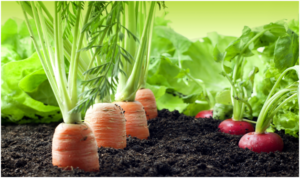Home / Blog / What Are Micronutrients?
An outbreak of locusts, spreading across parts of Africa, is threatening millions of people with hunger.
We all know that a balanced diet is one of the major factors affecting human health. But what exactly comprises a balanced diet, and how do we know that the foods we eat are actually healthy? These are key questions people must ask themselves when making lifestyle choices at the grocery store. As we fill our carts with food for the week, we often wonder whether we are making the right choices for our health. The answer to this question lies not just in the individual decisions we make but in the scrutiny of where food suppliers are getting our meat, dairy, and produce from. This includes considering micronutrients, micronutrient fertilizer, liquid phosphate fertilizer – especially related to Saudi Arabia micronutrients.
What are micronutrients?
In order for humans to be healthy, we must consume foods that provide our body with the vital substances it needs to function. These substances can be broadly classified into two categories: macronutrients and micronutrients.
While macronutrients refer to the proteins, fats, and carbohydrates that the human body needs in large quantities, micronutrients are the vitamins and minerals needed in much smaller amounts but are still essential for our survival. Vitamins and minerals are vital for a person’s growth, immune systems, brain development, and many other important functions. They are needed by our body to function smoothly and even help prevent serious diseases such as Alzheimer’s, heart disease, and cancer.
Despite improvements in nutritional knowledge and health care through the years, nutritional deficiencies still occur around the world, even in developed countries. In Saudi Arabia, too, micronutrient deficiencies have been observed. Recent research suggests that people of varying age groups, ranging from infants to students to pregnant women, may not be consuming adequate amounts of Vitamin D in the country. The same is true for other micronutrients such as iron and iodine. Even doctors in Saudi Arabia have been reported to suffer from micronutrient deficiencies such as low Vitamin D levels.
While Saudi Arabia’s micronutrient status is still better than other countries in the region, it’s still important for some changes in eating patterns to be made. Since the human body does not produce vitamins and minerals on its own, it must derive them from the food we eat in our daily diet. We take in the vitamins that plants and animals produce or the minerals they absorb. For this reason, we must monitor whether the plants and animals we consume are able to produce the micronutrients that we need.
This is where fertilizers come in. Poor soil nutrition hinders plant growth and prevents animals and humans from consuming vitamin- and mineral-rich food. However, organic fertilizers such as liquid phosphate fertilizers are a supplier of micronutrients and can counteract a deficiency in the soil to promote plant health, and in turn, animal and human health.
Types and Functions of Micronutrients
Before we discuss the role of fertilizer in fulfilling our nutritional needs, let’s first take a look at some examples of micronutrients and their benefits to our health. There are four main groups of micronutrients: water-soluble vitamins, fat-soluble vitamins, macrominerals, and trace minerals.
Water-soluble vitamins such as Vitamin B and C help in the discharge of energy and essential substances within the body so that essential processes such as the creation of red blood cells and regulation of metabolism occur smoothly.
These kinds of vitamins are hard to store in the body and excess amounts tend to be flushed out with urine. This is why they must be regularly consumed through our diet. Humans get their supply of Vitamin B and C by consuming meat, fish, milk, etc. In order to increase our intake of certain vitamins, we have to consume specific types of produce and grains through which they can be absorbed.
For instance, green peas, avocados, mushrooms, and potatoes are all good sources of Vitamin B3 or niacin, while Vitamin B9 or folate can be found in foods such as almonds, spinach, sweet potatoes. Citrus fruits and cruciferous vegetables like cabbage, broccoli, and Brussels sprouts are rich in Vitamin C.
Deficiency in water-soluble vitamins results in unpleasant symptoms. For instance, when a person is low in Vitamin C, they can experience swollen joints, slow-healing injuries, bleeding gums, and compromised skin, hair, and nails. Folate or Vitamin B9 deficiencies are the leading cause of neural tube defects, a serious birth defect.
All other vitamins are fat-soluble vitamins that are stored in the liver and fatty tissues for subsequent use in essential bodily functions such as vision (Vitamin A), immune function (Vitamin E), blood clotting (Vitamin K), bone development (Vitamin D, K), etc.
Again, specific foods deliver specific vitamins to the human body. Green, leafy vegetables and orange- and yellow-colored fruit provide Vitamin A, while nuts such as almonds, hazelnuts, peanuts, and sunflower seeds supply Vitamin E. Leafy greens such as kale, spinach and collards are good sources of vitamin K, and Vitamin D can be consumed by eating fatty fish and beef liver. There are not many plant-based sources for Vitamin D, so doctors often prescribe supplements and sunlight to people suffering from Vitamin D deficiencies.
Deficiency in fat-soluble vitamins can have worrying consequences for our health, such as loss of bone density (due to low levels of Vitamin D), night blindness (Vitamin A), and muscle weakness (Vitamin E). Children with a deficiency in Vitamin A face an increased risk of blindness and death from infections such as measles and diarrhea.
Macrominerals are the minerals that the human body needs in greater amounts than trace minerals. Macrominerals include calcium, phosphorus, magnesium, sodium, chloride, potassium, and sulfur. Trace minerals are iron, manganese, copper, zinc, iodine, fluoride, and selenium.
Calcium, which is needed for healthy bones and teeth, is found in dairy products and green, leafy vegetables. Sodium and chloride, required for regulating blood pressure and some digestive processes, are found in salt. Potassium is also needed in significant amounts for effective nerve and muscle function and can be found in fruits such as bananas, oranges, and grapefruit as well as vegetables like mushrooms, peas, and potatoes. Phosphorus, which makes up part of our bone and cell membrane structures, can be consumed through beans, lentils, and nuts as well as meat and dairy products. Sulfur, which makes up our tissues as well as certain amino acids, can be taken in by eating eggs, garlic, onions, and Brussels sprouts. Most mineral water is also enriched with sulfur.
Mineral deficiency can be detrimental to our health. For instance, a person with low calcium levels will start off experiencing painful cramps and persistent fatigue, but these symptoms can develop into more serious bone conditions such as osteopenia and osteoporosis.
Although needed in relatively minute amounts, trace minerals serve key functions such as providing oxygen to muscles (iron), making tissues (copper), thyroid regulation (iodine), and wound healing (zinc). These substances are also variously sourced from produce such as iron from spinach, copper from mushrooms, and zinc from lentils.
Like macro minerals, trace minerals also need to be maintained at proper levels or health concerns can develop. For instance, anemic people with low iron levels suffer from weakness, shortness of breath, chest pains and can go on to experience worse conditions such as heart problems. Children and pregnant women are especially vulnerable to the consequences of iron deficiency. Anemia during pregnancy increases the risk of maternal and perinatal mortality and low birth weight.
Micronutrients and Plants

By examining the different types of micronutrients and their plant sources, we can conclude that the health of plants is very closely linked to our own. How do we ensure that plants are thriving? It turns out that they need some of the same minerals as our bodies.
Plants suffer without sufficient presence of certain minerals in the composition of the soil in which they grow. There are approximately 17 nutrients that are crucial for the healthy development of plants, six of which are needed in significant amounts.
The list of major nutrients includes nitrogen, phosphorus, potassium, magnesium, sulfur, and calcium. They create new cells in plants, allowing for the growth of healthy tissue.
Let’s examine how each of the above minerals plays this role.
Nitrogen, made available to plants through the presence of nitrates in the soil, is a key element in plant growth. It helps the development of plant leaves, and together with magnesium, contributes to the development of chlorophyll, which gives plants their green color. Low nitrogen levels in soil result in stunted plants with small leaves and weak stems. Root systems tend to be weak and are not likely to support the growth of the plant.
Phosphorus helps plants turn sunlight into energy, thereby facilitating its maturity and helping the development of roots and flowers. It also contributes to the robustness of a plant, helping it fight against stressors in the environment such as harsh weather.
Potassium helps plants to fight disease and pests. It is one of those substances that strengthen a plant during its early growth phase, enabling it to store water and move substances such as starches, sugars, and oils where they are required. When soil is low in phosphates, it slows down essential processes like root formation, reproductive development, and the synthesis of proteins.
Sulfur prevents diseases from attacking plants while they produce seeds. Additionally, it aids in the production of substances such as amino acids, proteins, enzymes, and vitamins. Sulfur is also responsible for flavor and odor compounds in plants such as onions and cabbage. Low sulfur soil produces plants that are slow to grow.
Calcium is another disease-fighting nutrient that helps plants build up their cell walls as well as roots and leaves. It also helps plants absorb nitrates, which are essential for growth. Due to this, calcium deficiencies in plants manifest in poor fruit, wilting leaves, and weak roots.
Like humans, plants also need to absorb some trace minerals from the soil environment. While iron is essential for overall plant growth, specific trace minerals help with the development of specific parts of plants. Copper is needed for enzymes, boron for cell walls, and zinc for leaves and stems. Manganese helps plants convert sunlight into energy, and so helps in sustaining their growth. Other trace minerals that matter to plant health include chlorine, nickel, and molybdenum.
Micronutrient Fertilizer Boost Soil, Plants, and Health

Now that we’ve established that the composition of soil has a direct impact on human health, let’s look at some of the environmental factors that can cause nutritional deficiencies in plants.
While plants absorb certain important substances such as carbon, hydrogen, and oxygen from the air and water around them, it relies on the soil to supply other necessary micronutrients. Ideally, the soil should be able to provide all of these nutrients; however, they are often depleted by certain environmental conditions.
Nitrates are removed in large quantities from the soil by either leaching to groundwater or by escaping as nitrogen or nitrogen oxide gases. Another example is phosphates, which are mainly lost when water naturally drains away from soil or erosion takes place. Potassium loss is also common. It is either leached away or removed in large quantities when certain crops such as corn are removed.
As a plant food, fertilizers can be used to compensate for the nutritional deficiency found in soil. They supply plants with the elements that may be missing or in short supply in a form that is immediately absorbable by plants for faster growth.
One small-scale, home-grown fertilizing solution is compost, which involves the use of organic waste to enrich the soil. However, for large-scale projects like crop fields, growers use liquid fertilizers, which are quick to be dispensed and absorbed by plants.
Liquid phosphate fertilizers are often found in NPK combinations, containing nitrogen, phosphates, and potassium, the three nutrients that have been identified as most essential to plant survival. Other popular fertilizer types include calcium phosphate liquid fertilizer, ammonium phosphate liquid fertilizer, potassium phosphate liquid fertilizer, which can be used to target specific deficiencies in the soil and accelerate plant growth.
With the right micronutrient fertilizer, especially those with the right composition and mixtures, growers can compensate for the loss of nutrients in the soil – using proper practices- and improve the quality of plants grown for our consumption. For more information on how we can help you with making the right decisions related to micronutrients, contact us.












